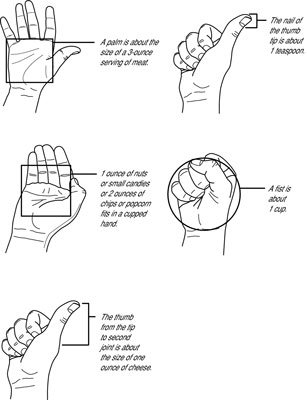When considering your nutritional needs, the amount you eat is as important as what you eat. Because people have diets filled with restaurant and convenience store foods, it’s difficult to remember how large a serving should be.
Portions of takeout food are much larger than the standard portion sizes defined in the Food Guide Pyramid. Even cookbooks are instructing people to serve larger portions. For example, the 1964 edition of The Joy of Cooking recommends cutting a 13-x-9-inch pan of brownies into 30 bars; the 1997 version is cut into 16 bars.
The following table lists the sizes of many foods that constitute one serving.
| Food Group | One Serving Is . . . |
|---|---|
| Bread, cereal, rice, and pasta | 1 slice of bread; half a hamburger bun or English muffin; 1 small roll, biscuit, or muffin; 5 to 6 small or 3 to 4 large crackers; 1/2 cup cooked cereal, rice, or pasta; 1 ounce ready-to-eat cereal |
| Fruit | One whole fruit, such as a medium apple, banana, or orange; half a grapefruit; a melon wedge; 3/4 cup fruit juice; 1/2 cup berries; 1/2 cup chopped fresh, cooked, or canned fruit; 1/4 cup dried fruit |
| Vegetable | 1/2 cup cooked vegetables; 1/2 cup chopped raw vegetables; 1 cup leafy raw vegetables, such as lettuce or spinach; 1/2 cup cooked beans, peas, or other legumes*; 3/4 cup vegetable juice |
| Milk, yogurt, and cheese | 1 cup milk, 8 ounces yogurt, 11/2 ounces natural cheese, 2 ounces processed cheese. |
| Meat, poultry, fish, dry beans, eggs, and nuts | Amounts should total 2 to 3 servings (for a total of 5 to 7 ounces) of cooked lean meat, poultry without skin, or fish per day. Count 1 egg; 1/2 cup cooked beans, peas, or other legumes*; or 2 tablespoons peanut butter as 1 ounce of meat. |
| Fats, oils, and sweets | Use sparingly. |
* Note that you can count dry beans, peas, and other legumes as a serving of vegetables or a serving of meat, but the same bowl of beans can’t count as a serving from both groups.
The following table illustrates a few discrepancies between what most people consider an “average” serving and the size that the USDA’s pyramid recommends.
| Food | USDA (In Ounces) | Perceived as Average (In Ounces) |
| Bagel | 2.0 | 4.0 |
| Cookies | 0.5 | 1.0 |
| Muffin | 1.5 | 5.5 |
| Potato | 3.9 | 6.5 |
A half-ounce of peanuts. An ounce of cheese. Two cups of popcorn. A quarter cup of sunflower seeds. A teaspoon of butter. A 3-ounce chicken breast. These are foods that you’re apt to run into when you’re eating on the run. After all, no one goes to a restaurant or movie theatre packing measuring spoons or cups. So how are you going to know what a serving of these foods look like?
A deck of cards is about the size of a 3-ounce chicken breast, but if the cards you play are on your computer screen, you may not recognize what a portion looks like. But you take something with you wherever you go that can help you with portion size — the palm of your hand. That is, if you’re an average female. Gentlemen, hold your honey’s hand more often to get a sense of size. Better still, make sure to take her to restaurants and movies with you. Some other “handy” measurements are shown here.
>
 >
>
You can use your hand to judge portions sizes.
>
dummies
Source:http://www.dummies.com/how-to/content/what-counts-as-a-food-serving-anyway.html
No comments:
Post a Comment